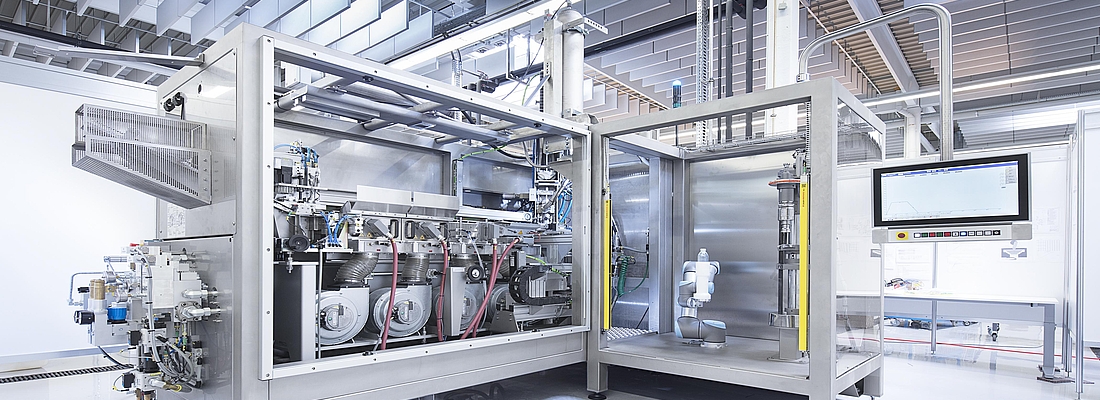At the drinktec trade show the filling and packaging specialist is demonstrating the new high-performance technology on a linear machine. KHS FormFill promises great savings potential regarding the system size, use of resources and further process execution. It also provides benefits with respect to the individualization of plastic packaging. The machine is to be ready for market by 2019 at the latest.


Enormous savings potential: for the first time the KHS FormFill integrates filling and stretch blow molding, to date two separate processes. (Photo: KHS)
KHS FormFill sparks revolution in processing of plastic packaging
The revolution in the processing of PET containers is drawing nearer: for the first time KHS presents a marketable concept for the forming and filling of plastic bottles which involves just one process step.
“Our system sparks a revolution in the processing of plastic containers in the high-performance range," emphasizes Prof. Dr.-Ing. Matthias Niemeyer, chairman of the KHS GmbH Executive Management Board. “Once again this development is driving technological progress in the industry.” In the FormFill process KHS will be integrating what to date were two separate processes into one for the first time ever, at the same time presenting a marketable machine concept. Up until now two individual function modules stretch blow molded the PET preform and then filled the resulting bottle in separate stages. With the KHS FormFill bottlers can now form and fill bottles on a single machine.
Soon also for aseptic and carbonated beverages
At drinktec KHS is presenting a demonstration system for the growth market of still water. The technology is also currently suitable for the filling of liquid soap and liquid detergents and for hot fill applications. “At the moment we’re concentrating our development on ensuring stable processes in these focus areas," explains Frank Haesendonckx, head of Sales and Technology at KHS Corpoplast GmbH and the person responsible for the project. Aseptic and carbonated beverages make greater demands of the new blow molding process. KHS wants to adapt the process for these beverages at the next stage in the project.
As in the conventional processing of plastic containers the machine heats up the preforms according to the required temperature profile. The product to be filled is then forced into the PET preforms under pressure with a controlled volume flow. The bottle is formed by the product to be filled as opposed to the compressed air used to date. In this process the preform material is automatically distributed along the inner contours of the container shape. The stretch rod aligns the bottle lengthwise and is automatically retracted from the container after filling. The given fill level is reached when the displacement volume is removed and before the cap is placed on the neck.
KHS FormFill yields enormous savings potential – and not just in line operation: by doing away with an entire function module and with the smaller diameter of the rotary machine the total amount of space required is reduced. In the current test environment of 40,000 bottles per hour the new procedure only needs about 25% of the installation space of standard stretch blow molder/filler blocks when filling beverages.
In line operation users will see a boost in efficiency with regard to time, energy and maintenance especially. As the conventional stretch blow molding process is no longer required, KHS FormFill fills PET containers more quickly. Forming and filling takes about the same time as the formerly separate stretch blow molding process. Saving on the high-pressure air compressor alone results in a considerable drop in energy consumption. Maintenance costs are cut by the use of fewer components and format parts.
FormFill as part of a turnkey system
The new machine can be integrated into existing packaging processes. “We regard FormFill as part of a turnkey system and are also studying the effects on downstream processes,” says Haesendonckx. Current findings even suggest that lower film thicknesses can be used for secondary and tertiary packaging. As the inside skin of the containers cools faster in the FormFill process than with the standard method thanks to direct filling, KHS produces containers of greater stiffness with the same wall thickness. This in turn allows further materials to be saved in the preforms. Design details such as logos can also be better processed, states Haesendonckx. “This increases the scope for individualization. Beverage and detergent brands then gain another unique selling point in the store.” Even if the preforms currently in use can be processed on the new plant equipment, KHS recommends that preform geometries are revised in order to exploit the possible potential for saving materials to the maximum.
The systems supplier wishes to commission the first FormFill rotary machine as a prototype in 2018, after which it is to be readied for market. The technology has already been tested for 0.5-, 1.0- and 1.5-liter PET bottles. KHS is also experimenting with the use of plastic polypropylene or polyethylene containers in the filling of liquid soap and liquid detergent in particular.
The comPETence center provides your organisation with a dynamic, cost effective way to promote your products and services.

magazine
Find our premium articles, interviews, reports and more
in 3 issues in 2026.



